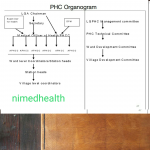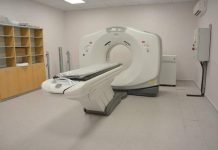Primary health care (PHC) is defined as essential health care based on practical, scientifically sound and socially acceptable methods and technology made universally accessible to individuals and families in the community through their full participation and at a cost that the community and country can afford to maintain at every stage of their development in the spirit of self reliance and self determination.
OUTLINE
- Introduction
- Components of primary health care
- Principles of PHC
- Pillars of PHC
- Misconceptions about PHC
- Implementation of PHC in Nigeria
- Steps in implementing PHC
- Administration and management of PHC in Nigeria
- PHC Human Resources
- The Referral system in PHC
- Current status of PHC in Nigeria
- Challenges of PHC implementation
- Conclusion
Introduction
• On 12th September, 1978, a joint conference on primary health care sponsored by WHO and UNICEF in Alma Ata, clearly recognized primary health care as key to achieving a state of complete physical, mental and social well being of all people of the world
• Primary health care (PHC) is defined as essential health care based on practical, scientifically sound and socially acceptable methods and technology made universally accessible to individuals and families in the community through their full participation and at a cost that the community and country can afford to maintain at every stage of their development in the spirit of self reliance and selfdetermination.
• PHC is the first level of contact of individuals, families and communities with the national health system
• In PHC, emphasis is placed on the main health problems in the community and services to be provided will as necessity include promotive, preventive, curative and rehabilitative services
COMPONENTS OF PHC
- Immunization against the major communicable diseases
- Prevention and control of locally endemic and epidemic diseases
- Maternal and child health, including family planning
- Environmental Sanitation: Adequate supply of water and basic sanitation
- Health education: Education on prevailing health problems and methods of controlling them.
- Adequate nutrition: Promotion of food supply and proper nutrition.
- Provision of essential drugs
- Appropriate treatment of common diseases and ailments
- Dental health care
- Mental health care
- Primary eye care
PRINCIPLES OF PRIMARY HEALTH CARE
- There are 5 universal principles of PHC
- Essential health care.
- Community participation
- Equity
- Use of appropriate technology
- Self reliance
- Intersectoral collaboration.
PILLARS OF PHC
• Political will
• Intersectoral Collaboration
• Community Participation
• Appropriate Technology
MISCONCEPTIONS ABOUT PRIMARY HEALTH CARE
- PHC is only of relevance to poor developing countries which cannot afford modern medical care
- PHC is second best medicine acceptable only to the rural poor and urban slum dwellers
- PHC is a stopgap solution to be replaced by something better at a latter stage
- PHC is a separate standalone service isolated from the main health care system
IMPLEMENTATION OF PHC IN NIGERIA
• The basic health service scheme (BHSS) was the first serious attempt at implementing PHC in Nigeria(1975-1980).
• BHSS concentrated on the provision of health facilities and training of health workers without giving much attention to community participation and use of appropriate technology
• The second attempt at implementing PHC was between 1980 and 1985
• During this period, the government began the implementation of the various programme components of PHC without any attempt to integrate the services and without any clearly mapped out plans and objectives.
• This led to fragmentation of services with both the states and the Federal government pursuing different objectives agreeable to them and donor agencies interested in some of the programmes.
Steps in implementing PHC
• Baseline Survey, whereby the major health problems of the community are identified (community diagnosis)
• Situation analysis aimed at determining the ability of health services to respond to problems considering the existing health resources and the presence of certain basic infrastructure that affect health e.g roads, water supply etc.
• Zoning the local government area into wards and assigning a health team to each zone or ward
• Registration of households i.e. household numbering and placement of home based records in each house
*NB: Registration of household is important to facilitate referral and followup
*Ward no – 2 digits
*Settlement no – 3 digits
*House no – 3 digits
Ex 1 : PHC-WARD| SETTLEMENT |HOUSE
06 012 001 – 999
*Home based cards:
There are 2 types
a)< 5 years
b)> 5 years and adults
Ex 2 : HOUSE no| HOUSEHOLD no| PERSON no which represents: 001 – 999, 01 – 99, and 01 – 99 respectively
Note :
01 – husband
02 – other heads of household (divorcee , single parent, widow)
03 – 19 – wives
20 – 59 – children (male: odd no, female:even no)
60 – 69 – Grannies
70 – 79 – dependants
80 – 89 – house helps
90 – 99 – others
• Community mobilization which includes formation of village and district health committees
• Training, including retraining of existing health workers
• Upgrading of existing health facilities to perform comprehensive PHC functions
• Monitoring and evaluation at home, clinic, community and local government levels of the various activities e.g Immunization coverage, family planning acceptance and usage, use of ORT and growth monitoring chart for children under 5 years.
NATIONAL PRIMARY HEALTH CARE DEVELOPMENT AGENCY(NPHCDA)
The federal government by decree number 29 of 1992 set up the NPHCDA as a parastatal of the FMOH to ensure sustainability of PHC in Nigeria.
• The agency is to mobilize support nationally and internationally for programme implementation, administer or commission studies on PHC issues to monitor the development of the Nation’s PHC programme and conduct periodic evaluation of PHC
• The country has been divided into six
zones with a zonal coordinator appointed for each zone for easy and effective co ordination, monitoring and supervision of PHC.
• The zonal coordinators report directly to the Executive Director, NPHCDA .
• The States and LGAs were also coordinators for the activities in areas.
to appoint their own
ADMINISTRATION AND MANAGEMENT OF PHC IN NIGERIA
• In each LGA, there should be various management committees to plan, manage, monitor and evaluate PHC services
• These committees are to ensure individuals and families in the community assume responsibility for their own health and for that of the community and develop capacity to contribute to theirs and the community’s development.
Committees at PHC level include:
- Village Development Committee
- Ward Development Committee
- PHC Technical Committee
- LG PHC Management committees
- Membership of the committees, depending on the level at which they exist, include the community leaders and other influential persons in the community, NGOs where present, women organizations, religious groups among other
The health centre is the most widespread and the most numerous structure for the delivery of health services in many developing countries.
Health centres because of their nearness to the population form the interface and link between communities and the health sector.
In Nigeria, three types of health centres are recognised within the PHC system.
The smallest unit is the health post, located at a place usually donated by the community and manned by a voluntary health worker (VHW).
Type I Health Centre (Basic health clinic)
• Consists of a small health facility with limited resources
• Has few staff and should have no inpatient facilities
• It is manned by community health extension worker.
• Offers in addition to promotive and preventive services, treatment of simple ailments and short illnesses on outpatient basis, referring the more serious cases to the primary and comprehensive health centre
Type II health centre (Primary health centre)
• Has more staff and more beds (about ten) usually for admission for maternity cases and an additional one or two for temporary admission of acute cases
• It is headed by community health officer or experienced nurse.
• Services include initial management of complicated pregnancies, diagnosis and treatment of common health problems, school health services, disease control etc.
Type III health centre (Comprehensive health centre)
• Largest of the health centre units
• Has about 30 beds comprising 10 maternity beds, 10 paediatric beds and 10 adult (male and female beds)
• Manned by a doctor
• Services include disease control and field activities, training of village health workers and TBAs, as well as preventive and promotive health services
• According to the BHSS of 1975, a comprehensive health centre should serve 50,000 persons, a Primary health centre 10,000 to 30,000 persons and a Basic health clinic 2000 persons.
• The ultimate objective, however will be to have a primary health centre for every 10, 000 persons.
PHC HUMAN RESOURCES
- Medical Officer of Health
- Community Health Officer (CHO)
- Public Health Nurse
- Community health extension worker (CHEW)
- Environmental health officer (EHO)
- Pharmacy technicians
- Laboratory technician
- Health attendant and support staff
- Volunteer Village health worker (VHW)/Traditional Birth Attendant (TBA)
- The Medical officer of health (MOH) is a doctor with postgraduate training in public health
- The MOH coordinates and supervises primary health care in the LGA and performs managerial ,technical and clinical functions
THE REFERRAL SYSTEM IN PHC
• Referral is a process by which a health care provider transfers the responsibility of the patient’s management temporarily or permanently to another health care provider or professional
• In PHC, referral is usually from the lowest level of care to the highest (from a health post to BHC to PHC to CHC to Hospitals) except in an emergency
Referral should occur in the following situations:
• When the patient needs expert advice
• When the patient needs a technical examination that is unavailable at the health centre
• When the patient requires technical information or procedure that is beyond the health centre
• When the patient requires protracted inpatient care
• When the patient requests for referral or transfer to another facility
• A good referral practice is the twoway referral system which implies that the higher centre receiving the patient should give relevant feedback about the patient to the referring centre after the patient has been seen and treated
• A two-way referral will allow exchange of ideas between health care providers, create better interaction as well as enhance transfer of knowledge between providers
• It also increases the chance of the patient receiving better care
• It increases patient satisfaction and decreases morbidity and mortality rates
• The Ward Health System represents the current national strategy for the delivery of PHC services
• Utilises the electoral ward as the basic operational unit
• The ward is the smallest political structure, consisting of a geographical area with a population range of 10,000 to 30,000 people
• There are on the average, ten (10) wards per LGA, each represented by an elected councillor
Aims of Ward Health System include:
• To promote full and active community participation at the grass root level
• To improve access to quality health care and ensure equity
• To promote local initiatives and encourage poverty alleviation activities in the ward
• To reinforce political commitment at grass root level
• To reduce morbidity and mortality especially amongst women and children under five years
CURRENT STATUS OF PHC IN NIGERIA
• The need to ensure equity in the delivery of health care services and improve access, informed the development of the Ward Minimum Health Care Package (WMHCP) in line with the Ward health system currently being implemented at the Primary health care level in Nigeria
• The Ward Minimum Health Care Package describes a priority set of health interventions which should be provided in PHC centres on daily basis, at all times and at little or no cost to clients through government financial mechanism.
• Technically, this package comprises of costeffective interventions known to promote health and development and reduce mortality and morbidity from major/ common illnesses.
The Minimum Health Care Package consists of the following six (6) interventions:
• COMPONENT 1: Control of Communicable Diseases
*Diseases targeted for eradication (Leprosy, Guinea worm, Onchocerciasis, Poliomyelitis)
*Notifiable diseases (Meningitis, Cholera, Yellow fever)
*Diseases of public health importance (Malaria, TB, STI, HIV / AIDS)
• COMPONENT 2 : Child Survival strategies
*Neonatal care *Routine immunization
*Integrated management of childhood illnesses.
• COMPONENT 3: Maternal and Newborn Care
*Basic essential obstetric care centre, made up of;
(1)4 midwives (2) 24hrs services
(3) Manual removal of placenta (4) Antenatal care, neonatal care, postnatal care
(5)Provision of basic obstetrics drugs (iron, folate, oxytocin, misoprostol, sedatives and antibiotics) and (6)Transport in case of referral
• COMPONENT 4: Nutrition
• COMPONENT 5: Non-Communicable Diseases Prevention
• COMPONENT 6: Health Education and Community Mobilization
• In order to implement this set of interventions, communities need to be mobilised using appropriate IEC strategies.
• Functional health infrastructure, human resources/manpower and financial resources would also need to be provided to support health service delivery at the ward level.
• The following services are therefore required: *Provision of Essential Drugs
*Human Resource for Health *Health Infrastructure development.
CHALLENGES OF PRIMARY HEALTH CARE IMPLEMENTATION
- Poor political will
- Inadequate funding
- Lack of human resource planning
- Minimal community participation
- Poor supervision
CONCLUSION
Primary health care involves
• promotion of community participation in planning, management, monitoring and evaluation of the local government health system
• Improved intersectoral collaboration in primary care delivery;
• Enhancing functional integration at all levels of the health system;
• Strengthening of the managerial process for health development at all levels.

Credit:
Dr. Efe Longe-Agho
Senior Registrar, Department of Community Health, University of Benin Teaching Hospital, (UBTH).

























I NEED YOUR ADDRESS
I wish you could make me understand your question
Nice article, please sir what are the composition and function of state and national implementation committee in phc.
Pls sir what are the composition and functions of state primary health care implementation committee
This is the whole of my community health posting lectures (apart from statistics and epidemiology) described in one blog post. Well done.